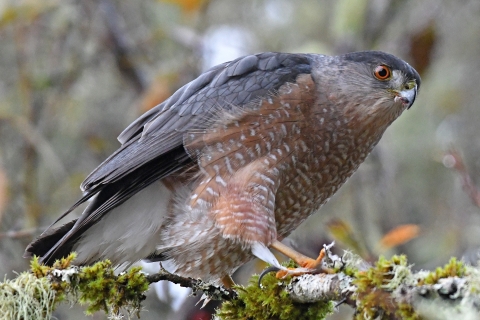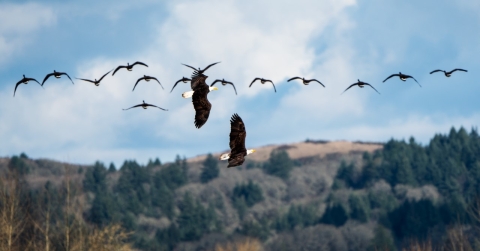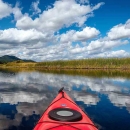Visit Us
The refuge is open every day from dawn to dusk and is always free. The refuge is bordered by Ankeny Hill Road, Buena Vista Road, and Wintel Road to the north, west and south respectively, and visitors can access refuge trails and/or viewing areas from each.
Ankeny National Wildlife Refuge, in partnership with Salem Audubon and the Friends of the Willamette Valley National Wildlife Refuge Complex, have created an environmental education hub for the Mid Valley: the Ankeny Hill Nature Center. The Ankeny Hill Nature Center offers everything from a Nature Explore Area to trails, education nodes and picnic areas. For more information, visit the Nature Center website: www.ankenyhillnaturecenter.org.
Observation blinds located on Rail Trail, Pintail and Egret Trails are a great way to get a closer view of the variety of waterfowl on the Refuge. If you want to photograph birds, stop by Pintail and Eagle Marsh. For a boardwalk hike, go to Rail Trail. Just want to drive up and watch wildlife for a while and escape? You'll find your favorite place here.
Location and Contact Information
About Us
Located near the confluence of the Willamette and Santiam Rivers, Ankeny National Wildlife Refuge was established in 1965. This historic wetland area provides overwintering habitat for the dusky Canada goose and other migratory waterfowl.
The refuge is a network of restored wetlands, providing year-round water for waterfowl and important resting and roosting habitat for both resident and migratory birds. The refuge's grass seed fields are managed to provide winter forage for geese. The refuge also provides riparian riparian
Definition of riparian habitat or riparian areas.
Learn more about riparian forest sanctuary for wildlife which range from the tiny Pacific chorus frog to black-tailed deer.
Just off of Interstate 5, the refuge offers convenient access to miles of boardwalk and earthen trails as well as accessible viewing platforms. The refuge is home to the Ankeny Hill Nature Center, an environmental education hub for the Willamette Valley. Just off Ankeny Hill Rd. on the north end of the Refuge, here you'll find two loop trails, a Nature Explore Area, classrooms, education nodes, and a nature adventure designed for families and kids of all ages.
What We Do
Managing and restoring native Willamette Valley habitats is what we do. We provide homes for thousands of species - seven of which are designated as threatened or endangered.
Management Techniques
Prescribed Burning
The Willamette Valley National Wildlife Refuge Complex (NWRC) has an active prescribed burning program. The objectives of these burns are to restore and maintain native prairies and oak savannas, enhance populations of threatened and endangered species, improve food crops for Canada geese, and reduce the risks for severe wildfire. Most burning takes place in the late summer or early fall.
Agricultural lands
Through cooperative agreements with local farmers, refuge fields are planted to grow ryegrass, fescue, corn and pasture mixes. These crops are the preferred food for wintering Canada geese. During the winter months thousands of geese feed on the crops planted by farmers. These farming operations help reduce off-refuge crop damage by migratory birds.
Weed Control
Control of non-native, invasive weeds is an important management operation. Weeds present the single most significant threat to native plant communities and rare species. The refuge uses a combination of mowing, burning, slashing, hand pulling and herbicides to keep weeds in check.
Prairie Restoration
Throughout the refuges, former croplands are in different stages of being restored to native habitats. This process, which takes a number of years, includes clean-up of the fields of weeds and residual crops, site preparation for planting of native species and maintenance of the developing habitats.
The refuges are actively restoring both wetland and upland prairies and are working to enhance existing prairies that have been invaded by shrubs and small trees. The woody vegetation is cut and piled off-site where it is burned. Most treatment areas are selected to provide benefits to threatened and endangered plant species.
Water Management
Seasonally flooded wetlands require continual management to produce plants favored by waterfowl and other water-birds. Water levels are usually “stage-flooded” in the fall and winter using water control structures that allow variable levels. This helps maximize the food availability for migrating waterfowl. Managed levels are also important in the spring to prevent the establishment of undesirable non-native plants, like reed canary-grass. In the summer, most managed impoundments are dry, a natural cycle that native plants have adapted to.
Oak Habitat Restoration
The suppression of fire following European settlement in the Willamette Valley has dramatically altered oak woodlands and savanna. The refuge complex is selectively restoring these areas by removing invading Douglas fir trees that will eventually overtop and shade out the oaks. In addition, oak trees and shrubs are thinned in order to maintain an open grassland understory. Management of these sites is accomplished in concert with adjacent prairie habitats and benefits rare species.
Our Organization
Our Species
Ankeny National Wildlife Refuge supports several different species of plants and wildlife.
Over 230 different species of birds have been recorded on the refuge. Refer to eBird for more information on the birds of Ankeny and to contribute to the community science being done at the refuge.
Nesting and migrating waterfowl such as Ducks, Geese, and Swans frequent the several wetlands and marshes. Migratory songbirds can be found in the riparian riparian
Definition of riparian habitat or riparian areas.
Learn more about riparian forest and native prairie habitats. Mudflats and wetlands provide glimpses of migrating shorebirds. Raptors including Red-tailed Hawk, Cooper’s Hawk, Bald Eagle, Northern Harrier, American Kestrel, and Peregrine Falcon, frequent the pattern of waterways, ponds, and snag habitats.
Mammals that inhabit the refuge include Roosevelt Elk, Bobcat, Black-tailed Deer, Coyote, American Beaver and more! Small mammals such as Brush Rabbit, Eastern Fox Squirrel, Townsend's Chipmunk and more have also been recorded.
Nine different species of Amphibians and Reptiles such as the Common Garter Snake, Pacific Chorus Frog, Northwestern Garter Snake, Pond Slider, and more roam the refuge.
Refer to this partial checklist from iNaturalist for a better idea on the biodiversity that can be found at Ankeny National Wildlife Refuge.
Get Involved
More than 42,000 people volunteer their time and ideas each year to the U.S. Fish and Wildlife Service. Whether they work on the land, in a visitor center or with youth, they contribute to the conservation mission that reaches back more than a century.
Everybody has a different reason for volunteering. Whether you enjoy working outdoors, want to connect with like-minded people, want to help engage your community with public lands, help foster environmental stewardship, etc ... consider volunteering with your national wildlife refuge national wildlife refuge
A national wildlife refuge is typically a contiguous area of land and water managed by the U.S. Fish and Wildlife Service for the conservation and, where appropriate, restoration of fish, wildlife and plant resources and their habitats for the benefit of present and future generations of Americans.
Learn more about national wildlife refuge .
Interested in volunteering with us?
Email willamettevalley@fws.gov



